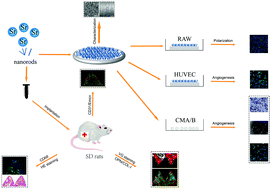A vessel subtype beneficial for osteogenesis enhanced by strontium-doped sodium titanate nanorods by modulating macrophage polarization†
Abstract
Early vascularization plays an important role in bone healing, especially in interfacial bone formation. Many modifications have been made to titanium surfaces to promote angiogenesis. In addition, cytokines secreted by osteoblasts have been reported to enhance early angiogenesis, however, the effect is limited because osteoblasts arise after inflammation subsides. We fabricated a newly sustained release system consisting of Sr ion-loaded sodium titanate nanorods (STSr) and studied its effect on angiogenesis by regulating macrophage subtypes. In an in vitro study, STSr significantly promoted the angiogenesis and formation of CD31hiEmcnhi vessels by modulating the transformation of M1 macrophages toward M2 macrophages. After incubation on STSr surfaces, macrophages (RAW264.7) polarized toward M2 subtypes and expressed high levels of PDGF-BB. Furthermore, the conditioned medium from RAW264.7 cells enhanced the ability of tubule formation and migration of HUVECs and their differentiation into pro-osteogenesis vessels (CD31hiEmcnhi vessels). In vivo studies showed high expression levels of CD31hiEmcnhi surrounding implants. Accompanied with enhanced vascularization, improved bone formation and osseointegration were observed. Our study serves as a basis for the clinical application of novel functional topography surfaces fabricated on titanium, which can be applied in new orthopedic implants for the better prognosis of patients.



 Please wait while we load your content...
Please wait while we load your content...